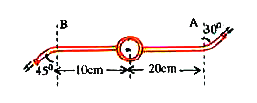lawn sprinkler with two nozzles of 0.1cm dimeter each, at 20cm and 10cm, radii is connected across a tap capable of liter/minute discharge. The nozzles discharge water up wards and outwards from the plane of rotation. What torque will the sprinkler exert on the hand

so ,QA=QB=3lit/min=3×10−360=50×10−6m3/s
The force exirted by the discharging water on the nozzle is given by F=ρVQ=ρQ2A
FA=Fa=1000×(50×10−6)2π4(0.01)2=31.85×10−3N
Torque about h and T =FAcos30∘×0.2+FB,45∘×0.1
=(31.85×10−3×√32×0.2)+(31.85×10−3×1√2×0.1)=7.78×10−3N−m
Topper's Solved these Questions
- FLUID MECHANICSBOOK - AAKASH SERIESCHAPTER - FLUID MECHANICSEXERCISE - Test your self
6 Videos
- FLUID MECHANICSBOOK - AAKASH SERIESCHAPTER - FLUID MECHANICSEXERCISE - Short answer type questions
13 Videos
- FLUID MECHANICSBOOK - AAKASH SERIESCHAPTER - FLUID MECHANICSEXERCISE - ADDITIONAL PRACTICE SHEET (ADVANCED) (Straight Objective Type Questions)
5 Videos
- EXPANSION OF SOLIDS BOOK - AAKASH SERIESCHAPTER - EXPANSION OF SOLIDS EXERCISE - Questions for Descriptive Answers
5 Videos
- FRICTION BOOK - AAKASH SERIESCHAPTER - FRICTION EXERCISE - ADDITIONAL PRACTICE EXERCISE PRACTICE SHEET (ADVANCED) (MORE THAN ONE CORRECT ANSWER TYPE QUESTIONS)
1 Videos
Similar Questions
A lawn sprinkler has 20 holes, each of cross-sectional area 2.0x10−2cm2, and is connected to a hose pipe of cross sectional area 2.4cm2. If the speed of water in the hose pipe is 1.5ms−1, the speed of water as it emerges from the holes is
View SolutionA garden hose with an internal diameter of 1.9 cm is connected to a (stationary) lawn sprinkler that consists merely of a container with 20 holes, each 0.15 cm in diameter. If the water in the hose has a speed of 0.91 m/s, at what speed does it leave the sprinkler holes?
View Solution
Knowledge Check
A lawn sprinkler has 20 holes, each of cross-sectional area 2.0x10−2cm2, and is connected to a hose pipe of cross sectional area 2.4cm2. If the speed of water in the hose pipe is 1.5ms−1, the speed of water as it emerges from the holes is
A2.25ms−1B4.5ms−1C9ms−1D18ms−1The figure shows the commonly observed decrease in diameter of a water stream as it falls from a tap. The tap has internal diameter D0 and is connected toa large tank of water. The surface of the water is at a height b above the end of the tap.
By considering the dynamics of a thin "cylinder" of water in the steam answer the following: (ignore any reistance to the flow and any effects of surface tansion, given ρw= density of water)

A student observes after setting up this experiment that for a tap with D0=1cm at x=0.3m the stream diameter D=0.9cm. The heights b of the water above the tap in this case will be:A5.7cmB57cmC27cmD2.7cmConsider two syringes with diameters of the smaller piston and larger piston being 1 cm and 3 cm respectively, excluding needle. Both are filled with water and are connected with a tightly fitted rubber tube filled with water. Now, if a force of 10 N is applied to the smaller piston, then what is the force exerted on the larger piston?
A30 NB60 NC90 ND100 N
A garden pipe has an internal diameter of 4 cm. It is connected to a lawn sprinkler that consists of 24 holes at the other end. Each hole is of radius 0.06 cm. If the water in the pipe has a speed of 80 cm s−1, find its speed through sprinkler holes.
View SolutionA garden pipe has an internal diameter of 4 cm. It is connected to a lawn sprinkler that consists of 24 holes at the other end. Each hole is of radius 0.06 cm. If the water in the pipe has a speed of 80 cm s−1, find its speed through sprinkler holes.
View SolutionA garden hose having an internal diameter 2.0 cm is connected to a lawn sprinkle that consists of an enclosure with 24 holes , each 0.125 cm in diameter. If water in the hose has a speed of 90.0cms−1 , find the speed of of 90.0cms−1, find the speed of the water having the sprinkler hole.
View SolutionA capacitor charged to 100V is discharged by connecting the two ptates at t=0 . If the potential difference across the plates drops to 1.0V at 10ms, what will be the potential difference at t=20ms.
View SolutionConsider Two metallic charged sphere whose radii are 20 cm and 10 cm respectively each having 150 microcoulomb positive charge. What is their common potential after they are connected by a conducting wire ?
View Solution
